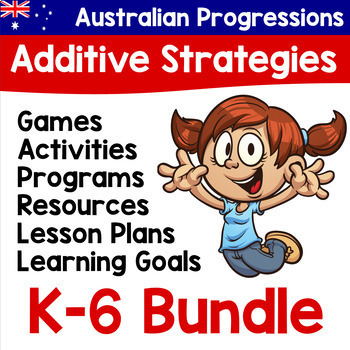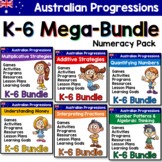Australian Numeracy Progressions - Additive Strategies Bundle
- Zip
Also included in
- This Mega Bundle contains all my existing bundles that support the Australian Numeracy Learning Progressions. I constantly make updates to these bundles as requested so please check back regularly.If there's something you'd like to see added or expanded upon in these bundles, please leave a Q&APrice $86.00Original Price $171.60Save $85.60
Description
This growing bundle contains activities and resources that align with the Australian Numeracy Progressions in the area of Additive Strategies. There are resources available across ALL progression levels. AdS1, AdS2, AdS3, AdS4, AdS5, AdS6, AdS7, AdS8
I will continue to add games and resources to this Bundle over 2019 and 2020 so always check back for updates! Updates will happen at a minimum of once per term :) If there is something you'd like to see in a future update, please send me an email at primaryactivityideas@gmail.com and I will endeavour to add that resource as soon as possible!
Last Update: May 2021
I have added a new resource for AdS8 - Decimal Pyramid Sheets.
This bundle includes resources and activities for the following Australian Numeracy Progressions:
AdS1
● combines two groups of objects and attempts to find the total
● compares two quantities of up to 10 and states which group has more
AdS2
● counts items that can be perceived by ones to find the total of two groups with one-to-one matching of number words and objects
● builds and subtracts numbers by using objects or fingers
● makes combinations to form numbers up to 10
AdS3
● solves additive tasks involving two concealed collections of items by visualising, ● counting from one to determine the total
AdS4
● treats a number word as a completed count when solving problems (‘I have 7 apples. I want 10. How many more do I need?’ Treats the 7 as a completed count)
● uses a strategy of count-up-from to calculate addition (to find 6 + 3, responds 6, 7, 8, 9. It's 9)
● uses a strategy of count-up-to to solve missing addends tasks (to solve 6 + ? = 9, responds 6 ... 7, 8, 9. It's 3)
AdS5
● uses count-down-from for subtraction tasks (9 – 3 = ?, 9 ... 8, 7, 6. It equals 6)
counts back to find the difference between two quantities where the difference is no greater than 4
● uses count-down-to to calculate (9 take away something equals 6, responds 9 ... 8, 7, 6 ... It's 3)
● finds the difference between two numbers less than 20
AdS6
● uses a range of non–count-by-one strategies when adding or subtracting two or more numbers (bridging to 10, near doubles)
● uses part-whole construction of number to partition a whole number into parts (partitions 7 into 5 and 2, 6 and 1, 4 and 3)
applies inverse relationship of addition and subtraction
AdS7
● applies knowledge of 10 as a unit to add and subtract 2 two-digit numbers (jump strategy, split strategy or compensation)
● manipulates tens and ones flexibly for addition and subtraction (to add 45 and 37, ● adds the tens on 45 … 55, 65, 75, then partitions the 7 into 5 and 2, adds the 5 to make 80 and 2 more to make 82)
● uses part-whole knowledge of numbers to 20 to calculate two-digit addition and subtraction (when finding 53 – 27, recognises the subtraction within as 13 – 7 and regroups the 53 into 40 and 13 and the 27 into 20 and 7)
AdS8
● manipulates hundreds, tens and ones flexibly to add and subtract 2 three-digit numbers (to add 250 and 457, ungroups the 250 into 2 hundreds and 5 tens, responds 457 plus 2 hundred is 657, plus 50 is 707)
● manipulates place value of numbers flexibly in regrouping for addition of three-digit numbers and beyond (when adding 650 and 550, regroups 650 as 600 and 50, adds 50 to 550, then doubles 600)
● manipulates place value of numbers flexibly in regrouping for subtraction (when solving 3000 – 260, treats the 3000 as 2700 and 300 to aid in mental calculation)
regroups for subtraction involving trading or exchange of units with different place values
● chooses and uses multiple strategies for solving everyday problems involving addition and subtraction






